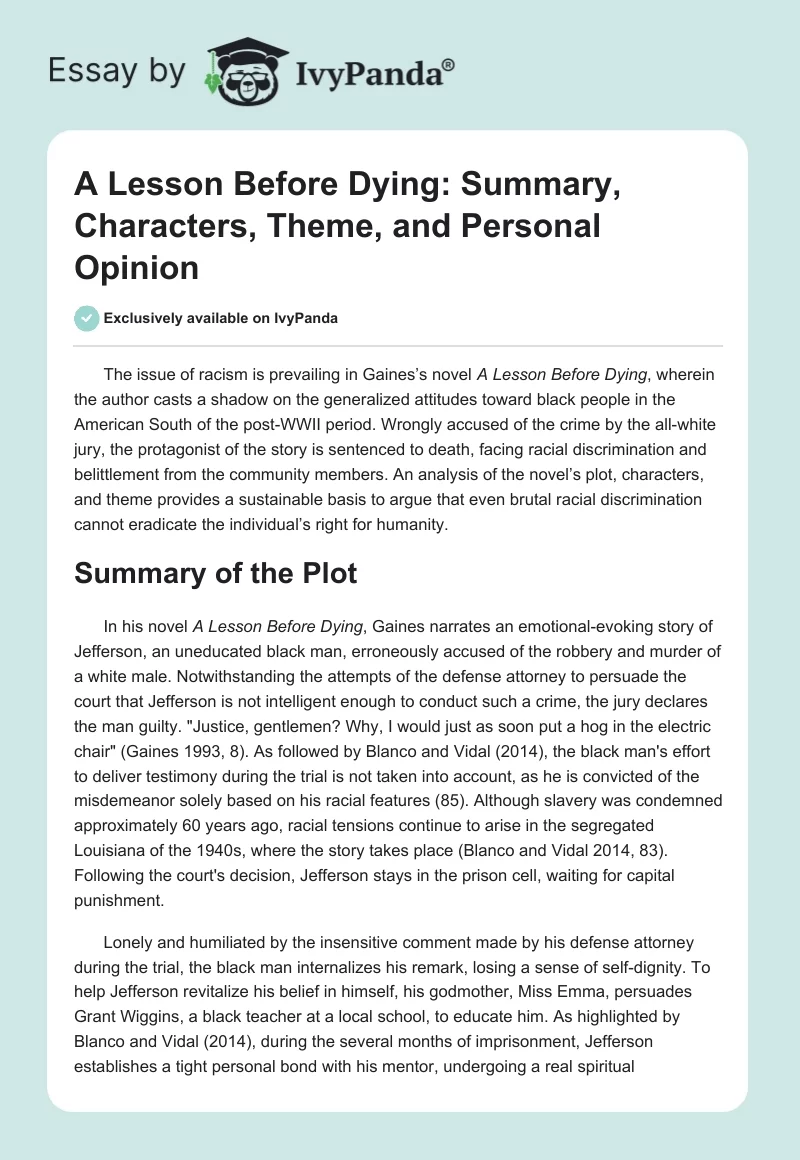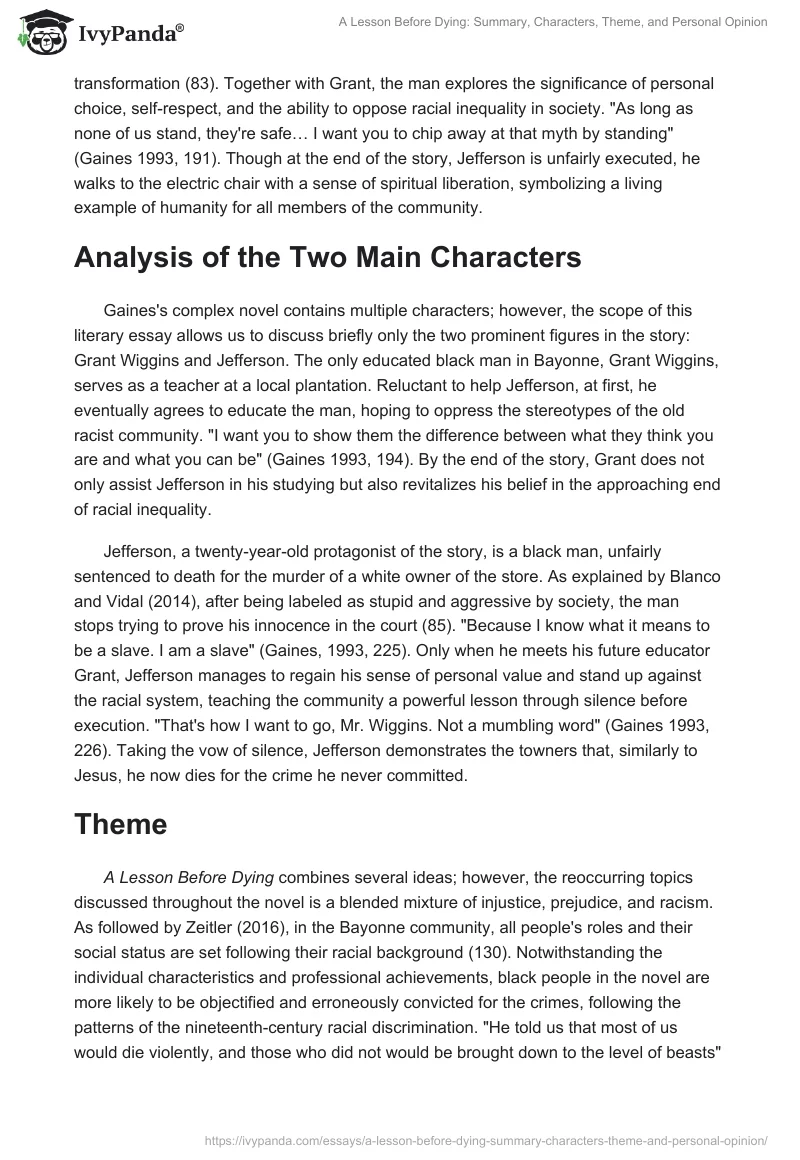The issue of racism is prevailing in Gaines’s novel A Lesson Before Dying, wherein the author casts a shadow on the generalized attitudes toward black people in the American South of the post-WWII period. Wrongly accused of the crime by the all-white jury, the protagonist of the story is sentenced to death, facing racial discrimination and belittlement from the community members. An analysis of the novel’s plot, characters, and theme provides a sustainable basis to argue that even brutal racial discrimination cannot eradicate the individual’s right for humanity.
Summary of the Plot
In his novel A Lesson Before Dying, Gaines narrates an emotional-evoking story of Jefferson, an uneducated black man, erroneously accused of the robbery and murder of a white male. Notwithstanding the attempts of the defense attorney to persuade the court that Jefferson is not intelligent enough to conduct such a crime, the jury declares the man guilty. “Justice, gentlemen? Why, I would just as soon put a hog in the electric chair” (Gaines 1993, 8). As followed by Blanco and Vidal (2014), the black man’s effort to deliver testimony during the trial is not taken into account, as he is convicted of the misdemeanor solely based on his racial features (85). Although slavery was condemned approximately 60 years ago, racial tensions continue to arise in the segregated Louisiana of the 1940s, where the story takes place (Blanco and Vidal 2014, 83). Following the court’s decision, Jefferson stays in the prison cell, waiting for capital punishment.
Lonely and humiliated by the insensitive comment made by his defense attorney during the trial, the black man internalizes his remark, losing a sense of self-dignity. To help Jefferson revitalize his belief in himself, his godmother, Miss Emma, persuades Grant Wiggins, a black teacher at a local school, to educate him. As highlighted by Blanco and Vidal (2014), during the several months of imprisonment, Jefferson establishes a tight personal bond with his mentor, undergoing a real spiritual transformation (83). Together with Grant, the man explores the significance of personal choice, self-respect, and the ability to oppose racial inequality in society. “As long as none of us stand, they’re safe… I want you to chip away at that myth by standing” (Gaines 1993, 191). Though at the end of the story, Jefferson is unfairly executed, he walks to the electric chair with a sense of spiritual liberation, symbolizing a living example of humanity for all members of the community.
Analysis of the Two Main Characters
Gaines’s complex novel contains multiple characters; however, the scope of this literary essay allows us to discuss briefly only the two prominent figures in the story: Grant Wiggins and Jefferson. The only educated black man in Bayonne, Grant Wiggins, serves as a teacher at a local plantation. Reluctant to help Jefferson, at first, he eventually agrees to educate the man, hoping to oppress the stereotypes of the old racist community. “I want you to show them the difference between what they think you are and what you can be” (Gaines 1993, 194). By the end of the story, Grant does not only assist Jefferson in his studying but also revitalizes his belief in the approaching end of racial inequality.
Jefferson, a twenty-year-old protagonist of the story, is a black man, unfairly sentenced to death for the murder of a white owner of the store. As explained by Blanco and Vidal (2014), after being labeled as stupid and aggressive by society, the man stops trying to prove his innocence in the court (85). “Because I know what it means to be a slave. I am a slave” (Gaines, 1993, 225). Only when he meets his future educator Grant, Jefferson manages to regain his sense of personal value and stand up against the racial system, teaching the community a powerful lesson through silence before execution. “That’s how I want to go, Mr. Wiggins. Not a mumbling word” (Gaines 1993, 226). Taking the vow of silence, Jefferson demonstrates the towners that, similarly to Jesus, he now dies for the crime he never committed.
Theme
A Lesson Before Dying combines several ideas; however, the reoccurring topics discussed throughout the novel is a blended mixture of injustice, prejudice, and racism. As followed by Zeitler (2016), in the Bayonne community, all people’s roles and their social status are set following their racial background (130). Notwithstanding the individual characteristics and professional achievements, black people in the novel are more likely to be objectified and erroneously convicted for the crimes, following the patterns of the nineteenth-century racial discrimination. “He told us that most of us would die violently, and those who did not would be brought down to the level of beasts” (Gaines 1993, 62). Such a revelation proves that there was no hope for Jefferson to be justified for the crime he never committed; thus, the only solution for him was to accept the sentence with dignity and humanity.
Gaines also focuses on the ways race contributes to the formation of an individual’s perceived identity in society. As noted by Magill (2016), prejudiced perceptions of the black find reflections in the image of the black man’s masculinity of the time, associated with violence and brutality (61). A notable example of such unjust prejudice is a perception of Grant in the community. “I tried to decide… Whether I should act like the teacher that I was, or like the nigger that I was supposed to be” (Gaines 1993, 47). Despite his honorable position as an educator, the man is still disparaged for his background.
Personal Opinion
In my opinion, the moral behind Gaines’s novel lies in the perspective that racism cannot be eradicated from society only by the passage of new legislation. A collective effort of the individuals is vital for the positive change in the discriminatory attitudes formed and maintained in the community for decades. A Lesson Before Dying also argues that people’s origins should not predetermine their destiny. Racial tensions described in the story do belittle not only the main character but also limit his freedom. Liberty, in this case, does not refer literally to Jefferson’s imprisonment, but rather to the lack of choice, education, and respect given to the black people in the times. “And that’s all we are Jefferson, all of us on this earth, a piece of drifting wood. Until we – each of us, individually- decide to become something else” (Gaines 1993, 143). In his writing, the author encourages readers to oppress inequality and remember that discrimination will continue existing in the community until people consciously choose to reject societal stereotypes.
Consequently, a brief examination of the novel’s plot and theme, along with the character analysis, suggests that racial features should not be the reason for an individual’s inhumane treatment. Although slavery was abolished decades ago, Jefferson is erroneously convicted for murder based on the societal racial prejudices. Nevertheless, by undergoing spiritual transformation after meeting Grant, the black man accepts the death sentence with dignity, teaching the community that all people, regardless of the race, deserve benevolence and respect.
References
Blanco, Maria-Jose, and Ricarda Vidal. 2014. The Power of Death: Contemporary Reflections on Death in Western Society. New York: Berghahn Books.
Gaines, Ernest J. 1993. A Lesson Before Dying. New York: Alfred A. Knopf.
Magill, David E. 2016. “Make Him a Man: Black Masculinity and Communal Identity in Ernest J. Gaines’s a Lesson Before Dying.” Studies in the Literary Imagination 49 (1): 61-76. doi: 10.1353/sli.2016.0005.
Zeitler, Michael. 2016. ““Mr. Joe Louis, Help Me”: Sports as Narrative and Community in Ernest J. Gaines’s a Lesson Before Dying.” Studies in the Literary Imagination 49 (1): 129-140. doi: 10.1353/sli.2016.0009.


